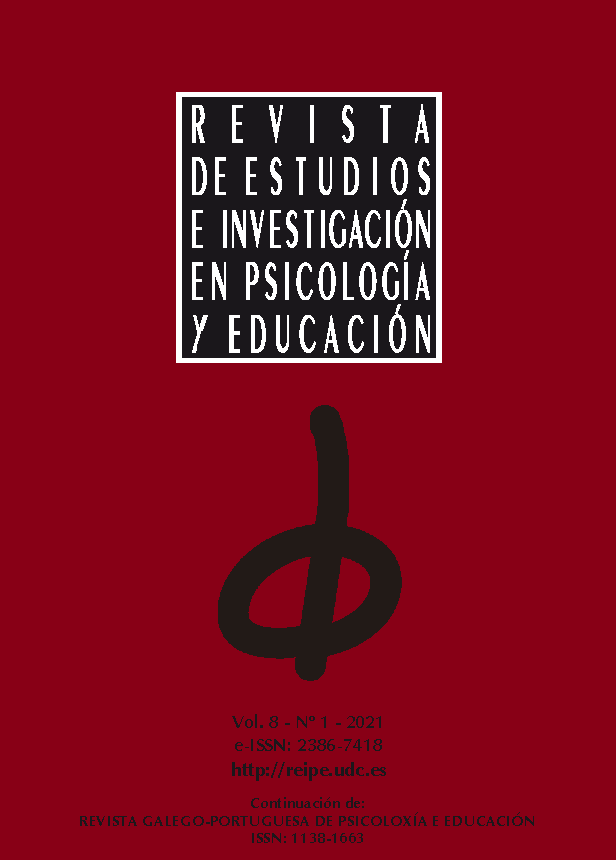Orientación espacial en preescolar: lateralidad y posición relativa
Contenido principal del artículo
DOI:
https://doi.org/10.17979/reipe.2021.8.1.6712Resumen
Neste artigo explora-se a orientação espacial, particularmente a lateralidade e posição relativa, em crianças da Educação Pré-escolar dos 3 aos 5 anos. A investigação centrou-se em três questões principais: a) Que conhecimentos têm as crianças sobre a sua posição relativa? b) De que forma as crianças descrevem o meio? c) Como se posiciona a criança em relação ao meio? Realizou-se uma intervenção pedagógica de 8 sessões, com 25 crianças duma sala de pré-escolar de ensino público. As tarefas de caráter individual e grande grupo centraram-se na orientação espacial, envolvendo noções de lateralidade (ao lado; esquerda/direita) e posição relativa (em cima/baixo; à frente/atrás; dentro/fora). Os resultados sugerem mudanças na capacidade de descrição da localização de objetos e pessoas, utilizando termos específicos adequados com mais frequência e maior facilidade, levando à melhoria da comunicação matemática. Ademais, as crianças demostraram serem capazes de perceber a sua posição no espaço e a dos objetos nele inseridos.
Palabras clave:
Descargas
Detalles del artículo
Referencias
ALVES, Cristina; & GOMES, Alexandra. (2012). Perceção de relações no espaço por crianças dos 3 aos 7 anos. In Hélia Pinto, Hélia Jacinto, Ana Henriques, Ana Silvestre & Cláudia Nunes (Org.), Atas do XXIII Seminário de Investigação em Educação Matemática (pp.181-192). Lisboa: APM. Disponível em: https://www.researchgate.net/publication/276353594_percecao_de_relacoes_no_espaco_por_criancas_dos_3_aos_7_anos
BALINHA, Filipa; & MAMEDE, Ema. (2017). O espaço da criança – explorar a geometria na Educação Pré-escolar. Revista de Estudios e Investigación en Psicología y Educación, 17(1), 185-190. https://doi.org/10.17979/reipe.2017.0.01.2546
BATTISTA, Michael. (1990). Spatial visualization and gender differences in high school geometry. Journal for Research in Mathematics Education, 21(1), 47–60. https://doi.org/10.2307/749456
BOGDAN, Robert; & BIKLEN, Sari. (2013). Investigação qualitativa em educação: Uma introdução à teoria e aos métodos (12th ed.). Porto Editora. (ISBN: 978-972-0-34112-9)
CLEMENTS, Douglas; SARAMA, Julie; DINE, Douglas; BARRETT, Jeffrey; CULLEN, Craig; HUDYMA, Aaron; DOLGIN, Ron; CULLEN, Amanda; & EAMES, Cheryl. (2018). Evaluation of three interventions teaching area measurement as spatial structuring to young children. Journal of Mathematical Behavior, 50, 23-41. https://doi.org/10.1016/j.jmathb.2017.12.004
COHEN, Lynn; & EMMONS, Janet. (2017). Block play: spatial language with preschool and school-aged children. Early Child Development and Care, 187(5–6), 967–977. https://doi.org/10.1080/03004430.2016.1223064
COHRSSEN, Caroline; WANDER, Ben; PAGE, Jane; & KLARIN, Suzana. (2017). Between the big trees: A project-based approach to investigating shape and spatial thinking in a kindergarten program. Australasian Journal of Early Childhood, 42(1), 94–104. https://doi.org/10.23965/AJEC.42.1.11
CRESWELL, John; & POTH, Cheryl. (2018). Qualitative inquiry and research design choosing among five Approaches (4th ed.). Sage Publications, Inc.
CROWN, Warren; CALDWELL, Janet; & ROSENSTEIN, Joseph. (2018). Standard 7 — geometry and spatial sense. New Jersey Mathematics Curriculum Framework, 209–249. https://www.state.nj.us/education/archive/frameworks/math/
ENGLISH, Lyn. (2016). STEM education K-12: perspectives on integration. International Journal of STEM Education, 3(1), 1–8. https://doi.org/10.1186/s40594-016-0036-1
FERNANDEZ-BAIZAN, Cristina; ARIAS, Jorge; & MENDEZ, Marta. (2021). Spatial orientation assessment in preschool children: Egocentric and allocentric frameworks. Applied Neuropsychology: Child 10(2), 171-193. https://doi.org/10.1080/21622965.2019.1630278
FRYE, Douglas; BAROODY, Arthur; BURCHINAL, Margaret; CARVER, Sharon; JORDAN, Nancy; & MCDOWELL, Judy. (2013). Teaching math to young children: A practice guide (NCEE 2014-4005). Washington, DC: National Center for Education Evaluation and Regional Assistance (NCEE), Institute of Education Sciences, U.S. Department of Education. Disponível em: https://ies.ed.gov/ncee/wwc/PracticeGuide/18
GERSMEHL, Philip; & GERSMEHL, Carol. (2008). Spatial thinking by young children : Neurologic evidence for early development and “educability”. Journal of Geography, 106(5), 181–191. https://doi.org/10.1080/00221340701809108
MENEGHETTI, Chiara; CARRETTI, Barbara; LANFRANCHI, Silvia; & TOFFALINI, Enrico. (2020). Spatial description learning in preschoolers: The role of perspective and individual factors. Cognitive Development, 53, 100841. https://doi.org/10.1016/j.cogdev.2019.100841
NATIONAL COUNCIL OF TEACHERS OF MATHEMATICS (2008). Princípios e normas para a matemática escolar (2ª ed.). Lisboa : Associação de Professores de Matemática (APM).
NEWCOMBE, Nora; & FRICK, Andrea. (2010). Early education for spatial intelligence: Why, what, and how. Mind, Brain and Education, 4(3), 102–111. https://doi.org/10.1111/j.1751-228X.2010.01089.x
OLIVEIRA, Eloisa; & BROCKINGTON, Gilherme. (2017). A importância do pensamento espacial. Educação. https://www.revistaeducacao.com.br/importancia-do-pensamento-espacial
RAMANI, Geetha; ZIPPERT, Erica; SCHWEITZER, Shane; & PAN, Sophia. (2014). Preschool children’s joint block building during a guided play activity. Journal of Applied Developmental Psychology, 35(4), 326–336. https://doi.org/10.1016/j.appdev.2014.05.005
SILVA, Isabel; MARQUES, Liliana; MATA, Lourdes; & ROSA, Manuela. (2016). Orientações curriculares para a educação pré-escolar (Despacho n.º 9 180/2016, de 19 de julho). Lisboa: Ministério da Educação/ Direção Geral da Educação (DGE). Disponível em: http://www.dge.mec.pt/recursos-0
TAQUETTE, Stella. (2019). Ensino do método qualitativo de pesquisa: revisão bibliográfica. Actas CIAIQ2019, 2, Investigação Qualitativa em Saúde//Investigación Cualitativa en Salud, 2, 1675–1684: https://www.proceedings.ciaiq.org/index.php/CIAIQ2019/article/view/2399
TRIFUNOVIC, Aleksandar; PESIC, Dalibor; CICEVIC, Svetlana; & ANTIC, Boris. (2017). The importance of spatial orientation and knowledge of traffic signs for children’s traffic safety. Accident Analysis & Prevention, 102, 81–92. https://doi.org/10.1016/j.aap.2017.02.019
VAN HIELE, Pierre. (1999). Developing geometric thinking through activities that begin with play. Teaching Children Mathematics, 5(6), 310–316.
VERDINE, Brian; GOLINKOFF, Roberta; HIRSH-Pasek, Kathy; & NEWCOMBE, Nora. (2017). Links between spatial and mathematical skills across the preschool years. Monographs of the Society for Research in Child Development, 82(1), 1–150. https://doi.org/10.1111/mono.12263



